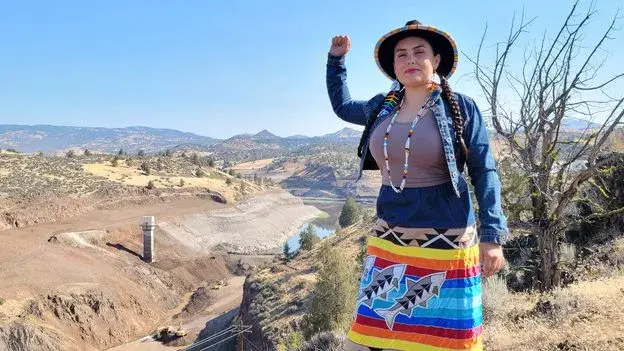- cross-posted to:
- dobre@szmer.info
The Klamath River is free of four huge dams for the first time in generations. But for the Yurok tribe, the river’s restoration is only just beginning – starting with 18 billion seeds.
Brook Thompson has been fishing on the Klamath River ever since she could stand up in a boat. To Thompson and her family, who are part of the Karuk and Yurok tribes from northern California, fishing is second nature. “The river was our grocery store,” the 28-year-old explains. That was until a catastrophic fish die off happened in 2002.
[…]
The dams have long been a point of contention for the tribe, who have been campaigning for their removal since the 1990s. The river is the lifeblood for the Yuroks, and the salmon are family. “The death of salmon means the death of our entire way,” Thompson says. “Everyone is connected. Taking these dams down is a life-or-death situation for us.”
Finally, at the end of August 2024, after years of negotiating, and decades of activism, the last dam fell, reopening more than 400 miles (644km) of river, in what is the largest dam removal project in US history.
[…]
Removing the dams is one thing, restoring the land is quite another," says Thompson, a civil engineer and part of the crew working on the restoration project – which is being managed by Resource Environmental Solutions, an ecological restoration company.
[…]
Between 2018 and 2021 seed collection crews – many of whom are tribal elders – were hired to harvest native seeds, by hand, in preparation for the dam removal. They collected 98 species and around 2,000lbs (900kg) of seeds. The seeds were then dispatched to specialised nurseries, which propagated them en masse, and sent the seedlings to storage facilities where they were kept until the time came for them to be planted.
A total of 18 billion native seeds were propagated – more than 66,000lbs (30,000kg) worth – each species selected for a purpose: to retain sediment, to prepare the soil for other plants, for cultural uses, or to be a food source. Wheatgrass, yarrow, lupine and oak trees – an important cultural species for the Yuroks and a keystone species – to name a few.
[…]
Seeds from trees and shrubs were also collected, which was a challenge during 2021 and 2022, particularly hot and dry years that exacerbated widespread wildfires.
[…]
But Thompson isn’t hoping to return to the past – she’s looking firmly to the future.
“There’s almost a bit of a fallacy in thinking like it will be returned to what it used to be,” Thompson says. “But I think with traditional ecological knowledge, tribal-led initiatives and current academic understanding of the landscape so you can almost make it better.”

To answer the title, several methane power plants that would have otherwise been shut down years ago get to keep operating for another twenty or thirty years, we loose significant potential for storing solar energy though the night, and we hit the point where the rivers get warm enough about half of all salmon worldwide stroke out and die just that bit earlier.
Heatwaves, droughts, and hurricanes are just that bit more powerful and commmon, and kill just a few more people each year for the next thousand years, but hey, the population of primarily one fish in one river will be higher for the next decade or two, and most importantly the fishing in that river will be easier.
I get that catching local salmon is culturally important for the locals, but I feel obligated to note the very real cost in human lives that will be paid primarily by the worlds poorest for centuries to come in order to stock one river.

As with most things, it is not that simple. First off, it is not one fish species:
Fall chinook salmon numbers plummeted by more than 90% and spring chinook by 98%. Steelhead trout, coho salmon and Pacific lamprey numbers also saw drastic declines.
That is a big part of the ecosystem, and losing all of that is also bad for people in the long term. Water quality was an issue with these dams, with toxic algae blooms being common. They are also restoring the ecosystem along the riverbanks, which should help mitigate the ever increasing wild fire threat that southern Oregon faces.
On the power production front, Oregon is moving away (albeit slowly) from methane plants. The plan is to be there by 2040, which is just over 15 years, not 30.
Overall, this is not a one or the other kind of thing. Restoring the rivers and habitats can, should, and is being done while simultaneously working to clean up the grid.

The salmon and their cultural impact have definitely been the driver of this and similar projects, and toxic algee blooms can and often are mitigated for far less than the cost of removing the dams. I also did not say that there was no local ecological benefit, mearly that there is a gobal ecological cost with far more direct impacts on human and habitat mortality as well as an impact on gobal salmon populations.
Note Oregon is moving away from methane plants, not completely eliminated from the entire Western Interconnection, indeed parts of the same grid are still building entirely new methane plants.
Even neglecting that the same money and resources could have been used to build more clean energy infrastructure instead of removing it, this is a very clear case of delaying cleaning up the grid in favor of perceived local benefits.
It actually is a very clear example of a one or the other thing. If we assume that power companies generally prioritize using renewable power over fossil, which given the cost of fuel they definitely do, and the gird will try and meet demand, then every kilowatt hour of clean energy removed from the grid is by definition a kilowatt hour of dirty energy added to the grid.
Had these dams continued generating electricity than that electricity would have taken the place of electricity produced by burning methane, and indeed given the often dispatchable nature of hydropower, it would have replaced methane from some of the dirtiest and least efficient methane plants on the grid, as methane plants designed to rapidly change power production are less efficient than ones operating at a constant output for long periods of time.
This is not clean power generation that will be built and start generating power at some time in the future, this was clean energy that was built and was operating for decades being removed, and as a result large quantities of methane are being burned as we speak that would not have been in a world where we waited on decommissioning these dams until after the last fossil plant was taken off the north american grid and then the fish that don’t stroke out because of the hotter river water were reintroduced.
Instead we are burning more methane gas today, we will continue burning that much more methane gas for every day until the last methane plant is shut down and which will now come that much later, and the results of burning that much more methane gas as well as the leaks in the infrastructure used to support it will continue to kill real people in the worlds poorest and most vulnerable communities each and every year for hundreds of years to come.

